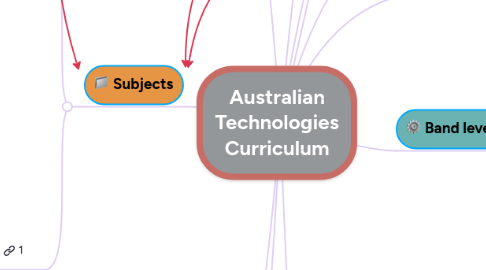
1. Subjects
1.1. Design and Technologies *see link*
1.1.1. Strands
1.1.1.1. Knowledge and Understanding
1.1.1.1.1. Technologies and Society
1.1.1.1.2. Technologies Contexts
1.1.1.2. Processes and Production Skills
1.1.1.2.1. Creating solutions by:
1.2. Digital Technologies *see link*
1.2.1. Strands
1.2.1.1. Knowledge and Understanding
1.2.1.1.1. Digital systems
1.2.1.1.2. Representation of data
1.2.1.2. Processes and Production Skills
1.2.1.2.1. Collecting, managing and analyzing data
1.2.1.2.2. Digital implimentation
1.2.1.2.3. Creating solutions by:
2. Aims and objectives
2.1. To develop knowledge, understanding and skills
2.1.1. Use traditional, contemporary and emerging technologies to understand how technology has developed
2.1.2. Investigate, design, plan, manage, create, prduce and evaluate technologies solutions
2.1.3. Make ethical and sustainable solutions about technologies
2.1.4. Evaluate technological processes to create solutions to problems and oppertunities
2.1.5. Design, plan and create products, services and digitl solutions by selecting and using technologies resources, materials, data, systems, tools and equipment
3. Key ideas/concepts
3.1. Overarching idea: Creating preferred futures: how solutions that are created now will be used in the future
3.1.1. Project management
3.1.2. Thinking in Technologies
3.1.2.1. Systems thinking
3.1.2.2. Design thinking
3.1.2.3. Computational thinking
3.1.3. Information and communication technology
3.1.4. Safety
3.1.5. Animal ethics
4. General capabilites
4.1. Literacy
4.2. Numeracy
4.3. Information and Communication Technology (ICT)
4.4. Critical and Creative Thinking
4.5. Personal and Social Capability
4.6. Ethical Understanding
4.7. Intercultural Understanding
5. Resources - Blog Posts
5.1. Scratch Jr - Coding for Kids!
5.2. The Buzz about Bee-Bots
6. Student diversity
6.1. Ensure all students are able to access and participate in the Australian Curriculum
6.1.1. Students with disability
6.1.2. Gifted and talented students
6.1.3. Students for whom EAL/D
7. Cross-curriculum priorities
7.1. Aboriginal and Torres Strait Islander histories and cultures
7.2. Asia and Australia's engagement with Asia
7.3. Sustainability
8. Content descriptors
8.1. Specify what the teacher is to teach including knowledge, skills and understanding which cater for individuals' learning needs and interests.
9. Band levels
9.1. F - 2
9.2. 3 - 4
9.3. 5 - 6
9.4. 7 - 8
10. Achievement standards *taken from curriculum - see link*
10.1. F - 2
10.1.1. Describe the purpose of known products, services and environments and how they meet a variety of current needs
10.1.2. List the features of technologies that impact design decisions and recognize how digital systems are used
10.2. 3 - 4
10.2.1. Describe how social, technical and sustainability factors impact on the design of solutions to meet present and future needs
10.2.2. Describe features of technologies that impact on design decisions and how a range of digital systems can be used
10.3. 5 - 6
10.3.1. Explain how social, ethical, technical and sustainability considerations impact the design of solutions to meet a range of present and future needs
10.3.2. Explain how the features of technologies influence design decisions and how digital systems are connected to form network s
10.4. 7 - 8
10.4.1. Explain how social, ethical, technical and sustainability considerations impact on the design of innovative and enterprising solutions to meet a range of present and future needs
10.4.2. Explain how the features of technologies influence design and production decisions
10.4.3. Make choices between different types of networks for defined purposes
10.5. 9 - 10
10.5.1. Explain how people working in design and technologies occupations consider factors that impact on design decisions and the technologies used to produce products, services and environments.
10.5.2. Identify the changes necessary to designed solutions to comprehend preferred futures they have described
10.5.3. Evaluate the features of technologies and their appropriateness for purpose for one or more of the technologies contexts when producing designed solutions for identified needs or opportunities
